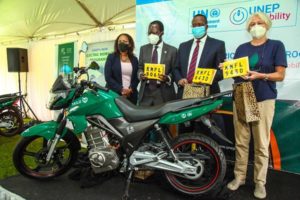Electrification is for many the answer to society’s urban air pollution problem. It promises to ‘green’ the motorcycles, taxis, buses and vehicles that meander through our cities daily, reducing noise and air pollution, while ensuring we have access to convenient, wheeled transportation.
A global leapfrog to electric vehicles is already underway, with countries like Norway leading, as much 70 per cent of the cars sold in the country in 2020 were electric. In other places, policymakers are piloting the first electric fleets, but urban health advisers underline that sustainable cities are more than just electric transportation.
“Electrifying transport, while lessening air pollution, cannot be oversold,” said Thiago Herick de Sa, a technical officer in the Department of Environment, Climate Change and Health at the World Health Organization. “We want people to walk, cycle or use public transport for most trips as much as possible, including the motorized ones.”
Over the past decade, sub-Saharan Africa has seen a significant growth in urbanization and subsequently the use of motorcycles as a commercial mode of public transportation has grown. While offering certain advantages, such as on-demand service, motorbike taxis have led to an increase in road accidents, traffic, noise and air pollution. Businesses and civil society have tried to regulate and improve the use of motorcycles through various programmes. While certainly not a sustainable solution to urban transport, motorcycling can help solve some travel challenges in specific contexts. One such initiative is in Kenya where the United Nations Environment Programme (UNEP) has partnered with the Shenzhen Shenling Car Company to donate 49 e-motorcycles to rangers in Nairobi’s Karura Forest.

UNEP launches initiative to provide 99 electric motorcycles to four partners: Karura Forest, Kenya Power and Lighting company, Power Hive and Kisumu County
The pilot project, which will be replicated in Uganda, Ethiopia, the Philippines, Thailand and Vietnam, aims to demonstrate the motorbikes’ capability to combat air pollution and climate change, as well as help bridge the travel divide in remote areas with poor road network as they transition to more sustainable territorial planning.
In the case of Karura Forest, instead of using petrol-fuelled motorcycles, rangers, who need to cross the 1000-hectare forest daily, will whizz around on an electric bike.
“Since it is fast and emits no noise and air pollution, like the diesel motor, they allow us to provide better security in the forest and tackle one of Nairobi’s worst environmental problems,” said John Chege, infrastructure coordinator from Friends of Karura Forest.
In Kenya, the number of newly registered motorcycles stood at 1.5 million in 2018 and is predicted to grow to five million by 2030. But while electrification of motorbikes will no doubt improve air quality, motorcycles continue to be a risk to public health in terms of road traffic accidents. According to WHO, more than half of all road traffic deaths are among vulnerable road users, such as motorcyclists.
More important, says Herick de Sa, is addressing sprawl and spatial segregation in cities. In an ideal urban environment, citizens wouldn’t have to travel those kilometres to reach places of work, school or essential services, as they would be a close distance to where they live.
“We need cities that are more compact; the 15-minute city,” he said referring to a concept where everything a resident needs can be reached within a quarter of an hour by foot, bike or public transport. “Electric motorbikes are a better way to overcome spatial segregation than fuel-powered ones, but ultimately we don’t want those kilometres travelled in the first place.”
The concept of the 15-minute city has been trialled in places like Barcelona, where “superblocks” — neighbourhoods of nine blocks— restrict traffic to roads around the outside, while opening up inner streets to pedestrians and cyclists. The superblocks reduce pollution from vehicles, and give residents a space to meet and do daily activities.
A study carried out by the Barcelona Institute for Global health found that if, as planned, 503 superblocks are created across the city, journeys by private cars would fall by 230,000 a week as people would walk or cycle.
“For cities to be safer and cleaner, we need citizens to avoid unnecessary motorized travel altogether,” said Herick de Sa. “That starts with designing our cities so that they are more compact, with everyone, poor and rich, old and young, living close to their daily destinations.”